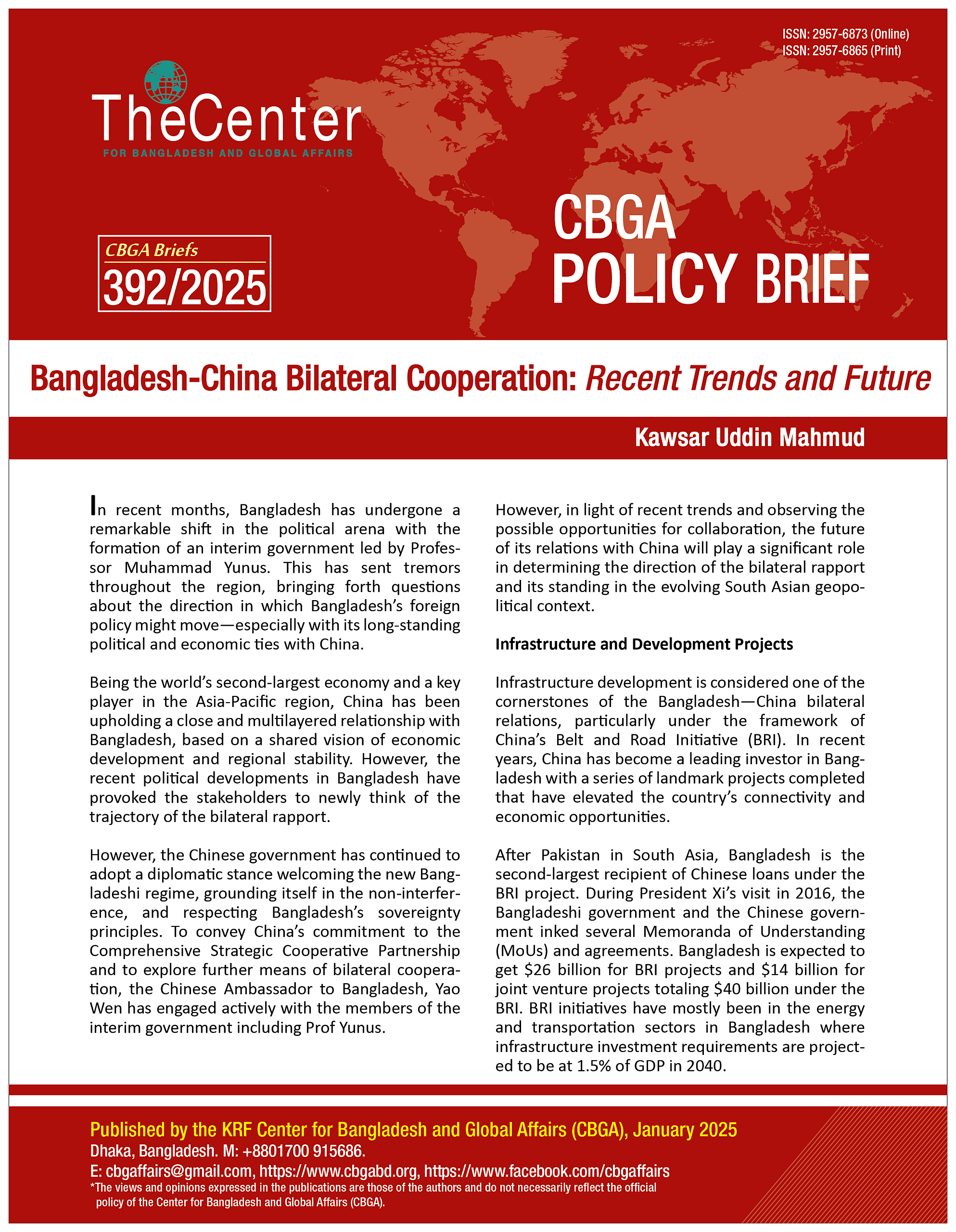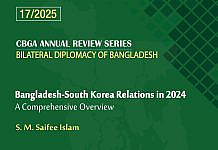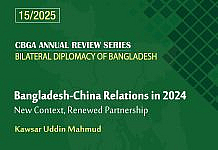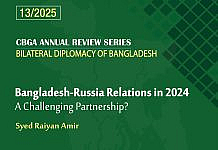
In recent months, Bangladesh has undergone a remarkable shift in the political arena with the formation of an interim government led by Professor Muhammad Yunus. This has sent tremors throughout the region, bringing forth questions about the direction in which Bangladesh’s foreign policy might move—especially with its long-standing political and economic ties with China.
Being the world’s second-largest economy and a key player in the Asia-Pacific region, China has been upholding a close and multilayered relationship with Bangladesh, based on a shared vision of economic development and regional stability. However, the recent political developments in Bangladesh have provoked the stakeholders to newly think of the trajectory of the bilateral rapport.
However, the Chinese government has continued to adopt a diplomatic stance welcoming the new Bangladeshi regime, grounding itself in the non-interference, and respecting Bangladesh’s sovereignty principles. To convey China’s commitment to the Comprehensive Strategic Cooperative Partnership and to explore further means of bilateral cooperation, the Chinese Ambassador to Bangladesh, Yao Wen has engaged actively with the members of the interim government including Prof Yunus.
However, in light of recent trends and observing the possible opportunities for collaboration, the future of its relations with China will play a significant role in determining the direction of the bilateral rapport and its standing in the evolving South Asian geopolitical context.
Infrastructure and Development Projects
Infrastructure development is considered one of the cornerstones of the Bangladesh—China bilateral relations, particularly under the framework of China’s Belt and Road Initiative (BRI). In recent years, China has become a leading investor in Bangladesh with a series of landmark projects completed that have elevated the country’s connectivity and economic opportunities.
After Pakistan in South Asia, Bangladesh is the second-largest recipient of Chinese loans under the BRI project. During President Xi’s visit in 2016, the Bangladeshi government and the Chinese government inked several Memoranda of Understanding (MoUs) and agreements. Bangladesh is expected to get $26 billion for BRI projects and $14 billion for joint venture projects totaling $40 billion under the BRI. BRI initiatives have mostly been in the energy and transportation sectors in Bangladesh where infrastructure investment requirements are projected to be at 1.5% of GDP in 2040.
However, the Padma Multipurpose Bridge, a 6.15-kilometer-long bridge spanning the Padma River, is one of the key examples of this cooperation. The bridge, completed in 2022, with Chinese money and Chinese technical expertise, connected the country’s south to its central capital Dhaka, moving people, goods, and services. Another BRI-backed project that has increased Bangladesh’s transportation and logistics capabilities is the Karnaphuli Tunnel which links the Chittagong port to the country’s northern regions.
During a BRI ceremony in Dhaka in September 2023, Yao Wen, China’s ambassador to Bangladesh, stated that China had constructed 12 highways, 21 bridges, and 27 power plants in Bangladesh. Improving the country’s overall infrastructure spine, ‘Chinese enterprises have generated 550,000 new jobs in Bangladesh,’ he added. These investments have not only contributed to the economic growth of Bangladesh but also brought about strong support to the strategic ties between the two countries where China became an important partner in Bangladesh’s development aspirations.
As Bangladesh faces the challenges of its LDC graduation in 2026, the country’s reliance on support from China via the BRI framework will be critical in facilitating a smooth graduation process and continued economic momentum. Wishing political stability and economic development for Bangladesh, China expressed to expand its cooperation with the country, accentuating the strategic value of such a partnership for the infrastructural and economic betterment.
Trade Dynamics
Over the years, China has emerged as one of the major sources of foreign direct investment (FDI) for Bangladesh. In FY18, over $1.03 billion was invested in Bangladesh by Chinese entities, followed by $626 million in FY19. However, the inflow decreased to $91 million in FY20 during the peak of the epidemic, as per data from Bangladesh Bank. In 2022, net FDI from China was 187 million, while in 2023, it was 260 million. A number of industries—ranging from manufacturing to energy to infrastructure—have benefited from these investments in which thousands of Bangladeshi workers are employed.
According to the Observatory of Economic Complexity (OEC), in September 2024, China exported $1.72B to Bangladesh and imported $92.3M—resulting in a positive trade balance of $1.63B for China. The exports of China decreased by $-118M (-6.4%) from $1.84B to $1.72B, though imports increased by $7.25M (8.53%) from $85M to $92.3M, from September 2023 to September 2024, giving rise to a positive trade balance for Bangladesh.
However, China’s commitment to strengthening economic ties with its South Asian partner further takes a recent announcement by the Chinese government to grant zero-tariff access to 100% of Bangladeshi products from December 2024. As a result, it is expected that this will widely raise Bangladesh’s exports of agricultural, industrial, and textile products to the Chinese market which is sorely needed for the country’s economy. In September 2024, Per OEC data, the top imports of China from Bangladesh were Non-Knit Men’s Suits ($4.96M), Knit T-shirts ($4.56M), Non-Knit Men’s Coats ($4.38M), Jute Yarn ($4.01M), and Processed Hair ($3.9M).
The strategic value of the upcoming Bangladesh-China partnership, however, is also recognized by the country’s interim government which seeks to deepen economic cooperation with China. The government has stated that it is willing to work with Chinese companies in a wide variety of sectors, including renewable energy, infrastructure, and high-tech industries. Foreign Advisor M Touhid Hossain said, “We need meaningful cooperation from China, and new avenues of collaboration must be explored by both sides.”
People-to-People Bonds and Cultural Exchange
This relationship between the two countries has also been marked by a broad tapestry of people-to-people exchanges and cultural cooperation. Education is one of the most notable engagement areas in this regard. Approximately 20,000 Bangladeshi students are currently pursuing their studies in China, taking advantage of the various scholarship programs and academic opportunities offered by the Chinese government. But these exchanges have not only been educational for Bangladeshi youth, but they have also helped build ties between the two countries in cultural exchanges.
Alongside the establishment of two Confucius Institutes at the University of Dhaka (DU) and North South University (NSU) and one Confucius Classroom in Bangladesh, the dissemination of Chinese language and literature has been made even more widely accessible in the country. In the past year, nearly 3,000 students have received language training and cultural training programs in these institutions. Similarly, the fact that more and more Bangladeshi students and professionals have begun learning Mandarin means that it is also very popular, as people are fond of it due to its growing importance in the world economy. The Centre for China Studies at the University of Dhaka has also emerged as a hub for academic and think-tank exchanges, further diversifying the intellectual ties.
However, the cultural exchanges between Bangladesh and China have also been on the rise, and in 2025, the two countries are expected to celebrate the ‘China-Bangladesh Year of People-to-People Exchanges.’ The implementation of this undertaking has allowed for a range of artistic, sports, and educational forums to occur that aim to broaden ties between the peoples of the two nations.
Regional Dynamics and Strategic Positioning
The strategic location and growing economic influence of Bangladesh make it an increasingly significant player in regional power dynamics. Since it is a key player in South Asia, Bangladesh has always been delicately balancing between its neighbors and major powers—India, China, the US, and other Western powers. The multi-alignment approach enables Bangladesh to exploit its geographical location and reap the benefits of cooperation with the different partners.
However, concerns relating to a change in the country’s foreign policy trajectory have been apparent among the Chinese government by the recent political changes in Bangladesh. The Foreign Advisor of Bangladesh stated that ‘Bangladesh’s political and economic trajectory will shape the direction of its relationship with China.’ Despite the development, the room for collaboration in the ‘defense, infrastructure, and overall development arena’ has not been turned off. He further said, “We need security cooperation from China”.
In this respect, maintaining a partnership and working solidly with China will be critical to the security and progress of the region. The delicate balance of power between China, the United States, and other powers throughout South Asia will be very crucial for Bangladesh in the coming periods. And China’s ability to assure Bangladesh that it remains committed to the bilateral partnership and non-interference in the country’s sovereignty and independence will be vital to overcome future challenges.
What Lies Ahead?
Bangladesh-China bilateral rapport has become notably a ‘comprehensive strategic partnership’ in the areas of infrastructure development, trade and investment, and people-to-people exchanges. This partnership has been a major contributor to the economic growth of Bangladesh, as well as to the regional influence of China, and is one of its main integrating factors. Despite the recent political changes in Bangladesh, both Bangladesh and China, no doubt, are committed to keep going on a positive track in the foreign policy arena to ensure the economic and development growth of Bangladesh and to maintain geo-strategic soundness in the South Asian region.
– Kawsar Uddin Mahmud is a Research Intern at the KRF Center for Bangladesh and Global Affairs (CBGA).







